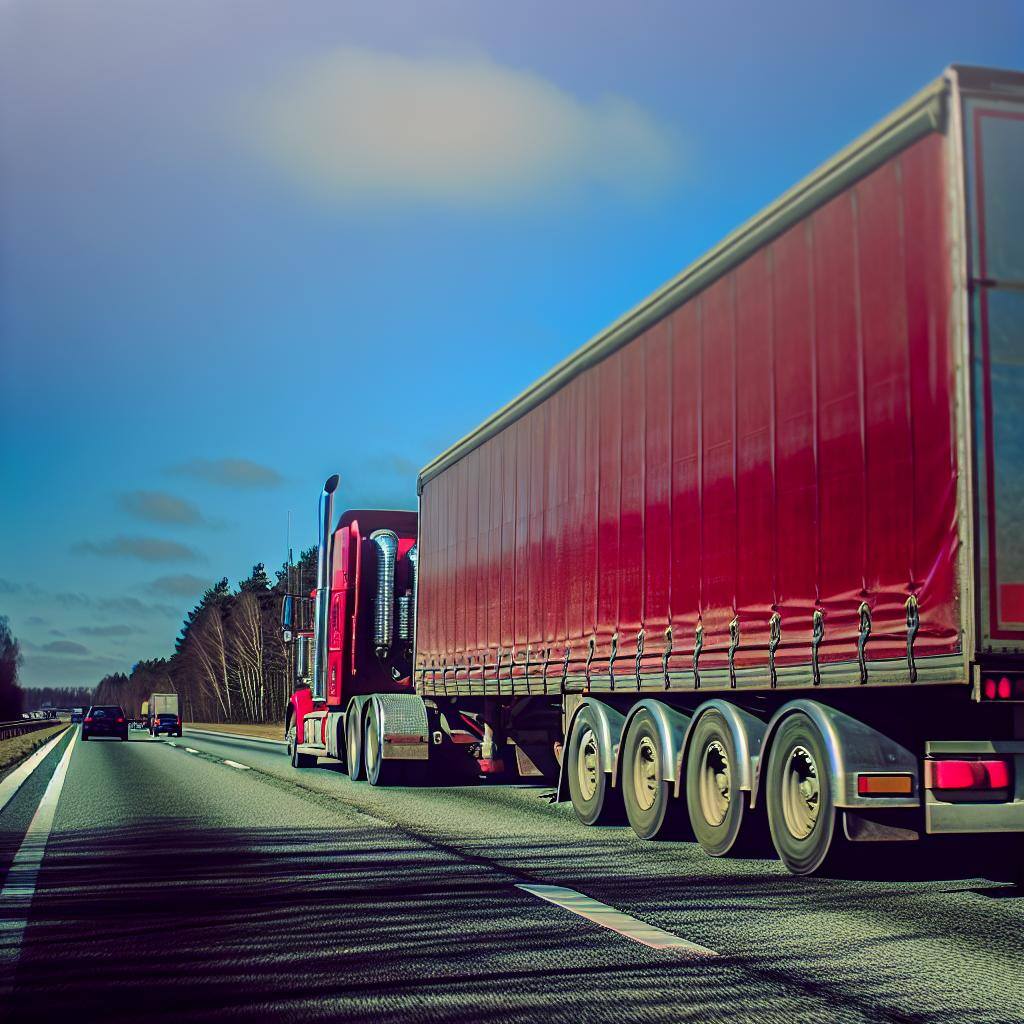In today's rapidly evolving transportation industry, the integration of trailer tracking into telematics has become increasingly important for providing full visibility into daily logistics operations. This visibility is important for facilitating full transparency with stakeholders and continuous improvement both now and in the future. In this blog, we’ll explore the process of integrating trailer tracking into telematics systems, highlighting the benefits, challenges, and best practices associated with this integration.
Increase Your ROI by Investing in AirFinder Everywhere
- Loss Prevention. Reduce the amount of loss that occurs during the supply chain process
- Location Coverage. AirFinder Everywhere uses a combination of GPS, Cellular, and WiFi to determine location everywhere
- Security Alerts. Know when a delay in shipment has occurred so the problem
can be addressed immediately.
Understanding the Difference Between Trailer Tracking and Telematics
Telematics systems are comprehensive systems that combine telecommunications and informatics to collect, store, and transmit real-time data on vehicle location, performance, and behavior. They typically consist of hardware installed in vehicles, such as GPS trackers and sensors, and software platforms that analyze and display this data. Telematics systems can provide a wide range of information, including vehicle location, speed, fuel consumption, and engine diagnostics. The collected data is then used by fleet managers to improve the efficiency, safety, and compliance of their operations.
Trailer tracking systems, on the other hand, focus specifically on monitoring the location and condition of trailers and their contents. These systems involve the use of GPS and cellular technology to monitor the location and condition of trailers, cargo, and portable equipment in real time. It typically consists of a tracking device installed on each individual asset, which communicates with a central software platform. This allows fleet managers to track the location of trailers, monitor their status, and optimize their use, as well as helping to ensure that trailers leave the yard with the correct assets on board.
Why You Should Integrate Trailer Tracking into Your Telematics
Integrating trailer tracking into telematics involves combining the hardware and software components of both systems to provide a unified solution. This integration allows fleet managers to track both vehicles and trailers from a single platform, providing a more comprehensive view of their operations. However, fleet managers are often quick to assume that since they have telematics, trailer tracking isn't necessary. After all, telematics systems are already required by law, so surely they cover everything that could be needed.
This assumption is simply not true. While telematics systems are incredibly robust on their own, they are only designed to provide visibility to trucks and powered assets. This means that they can only provide data on the truck and a connected trailer when the truck is hooked up and powered on. This does not lend itself to tracking disconnected trailers, which means that telematics systems alone can only provide limited value for fleet managers looking to improve the usage, maintenance, and utilization of their trailers.
Furthermore, telematics systems are not designed to provide data on trailer contents. The most that these systems can usually provide is the overall temperature or size of the load, with no granular data points on what’s actually in the trailer and what conditions those individual assets are maintaining. This makes it difficult to verify that trailers are loaded and unloaded correctly. It also means that temperature-sensitive goods cannot be monitored at the pallet or unit level. Since trailer trackers are independently powered and have a variety of tags that can be strategically employed to provide the data that you need, using these solutions can help you fill in the gaps that your telematics system is not designed to account for, providing a more complete, more reliable picture of every aspect of your logistics operations.
How to Integrate Trailer Tracking into Your Telematics
Integrating trailer tracking into your telematics system is the right move if you’re looking to improve your daily operations and stand out from your competition. The future is tech-enabled, and the added visibility that trailer tracking provides places you in a position to take full advantage of that future. However, trailer tracking integrations need to be approached strategically so that you can achieve the results that you want. In order to effectively implement a trailer tracking integration, follow the steps below.
1. Choose a Compatible System
The first step in integrating trailer tracking into telematics is to ensure that the trailer tracking system you choose is compatible with your existing telematics system. Compatibility is crucial to ensure seamless communication between the two systems and to avoid any potential issues down the line. Look for trailer tracking systems that are specifically designed to work with your telematics system or other management systems in general to ensure a smooth integration process. For instance, our AirFinder Everywhere solution for trailer tracking is designed to allow integration through MQTT and API streams. This type of integration is standard and compatible with most telematics and supply chain management systems, a proven solution for running multiple systems simultaneously.
2. Install the Trailer Tracking Hardware
Once you have chosen a compatible trailer tracking system, the next step is to install tracking devices on each trailer in your fleet. These tracking devices are typically small, rugged devices that can withstand the rigors of daily use on the road. It is important to ensure that the tracking devices are properly installed and securely attached to the trailers to prevent them from being tampered with or dislodged during transit. Installation also means outfitting the equipment and cargo you want to track with tags as well, although these tags might be removed and refixed over the course of the supply chain depending on how your operations run. With our solution, we suggest using permanent SuperTags within trailers and then affixing standard BLE tags to products and equipment. These tags will report to the SuperTag, which will then transmit the data they collect to the central system. This model allows you to save money on your installation and take advantage of the wide range of condition sensors available through our catalog of BLE tags.
3. Configure Software Settings
After the physical tracking devices have been installed, the next step is to configure the telematics software to recognize and communicate with the trailer tracking devices. This involves setting up the software to receive data from the tracking devices, as well as configuring any alerts or notifications that you want to receive based on the tracking data. It is important to carefully configure the software settings to ensure that you are capturing the data you need to effectively manage your fleet. The procedure for completing this step will vary depending on the telematics system you use and the trailer tracking system that you’re integrating, so it’s important to ensure that your chosen trailer tracking solution is backed by a team of experts that’s knowledgeable about this process and willing to guide you through it with regards to their system and your needs.
4. Implement Secure Data Transmission
To protect data transmitted between the trailer tracking and telematics systems, use encryption and other security measures. This ensures that your data remains secure and is not intercepted by unauthorized parties. Quality trailer tracking systems will already be designed to account for security concerns, especially if those systems are intended to be integrated with telematics and other external solutions. As with configuring settings and integrations, the team backing the system should be able to help you with this. However, you will also need to account for vulnerabilities in your telematics system, so make sure you consult with experts on that technology as well. Also, it’s helpful to establish a response plan for potential data breaches in the future. Although this is a worst case scenario, it is helpful to be prepared since the nature of security threats are always evolving and may catch your preparations and safety measures off guard, just as with any other system.
5. Test Integration
Once the hardware and software have been configured, it is important to test the integrated system to ensure that it is functioning correctly. This involves tracking a few trailers and other assets in real time to ensure that the tracking data is being accurately captured and transmitted to the telematics system. Essentially, you are using the system as you intend to use it across a wider installation, but only on a limited number of assets until you can verify that the integration is working. Testing the integration will help identify any issues or discrepancies that need to be addressed before fully deploying the system. Since only part of the system has been deployed, it’s a lot easier to fix any issues and simply set up the rest of the system within the context of the results of your tests.
6. Train Users
It is important to provide training to fleet managers and drivers on how to use the integrated system effectively. This includes training on how to access and interpret tracking data, as well as how to use any additional features or functionality that the integrated system may offer. Providing training will help ensure that your team is able to fully leverage the benefits of the integrated system and maximize its effectiveness. This process should not be difficult. One of the greatest benefits of implementing trailer tracking as an integrated system is that users will not need to be trained from scratch on how to use the system and access relevant data. Instead, since they likely already have a strong basis in the corresponding telematics system, you will only need to focus on training them in added components and functionality. This allows for a quicker, more efficient implementation process with less chances of uncertainty for your users.
7. Provide Regular Maintenance and Updates
Finally, after a successful implementation, you need to keep both the trailer tracking and telematics systems up to date with regular maintenance and software updates. This helps ensure that your systems are running smoothly and are protected against any potential security vulnerabilities. Regular maintenance and updates also help extend the lifespan of your systems and their components, saving you time and money on replacements down the road. The best way to ensure that you are conducting maintenance and updates when needed is to maintain a set schedule of hardware check-ins. Other factors that might require upkeep – such as battery changes and software updates – should be accounted for by an alerting system through the central solution that you simply need to respond to when it's flagged.
Add Trailer Tracking to Your Telematics with Link Labs
The integration of trailer tracking into telematics systems offers significant benefits for fleet managers, including improved asset visibility, enhanced operational efficiency, and reduced costs. By following best practices and choosing compatible systems, fleet managers can successfully integrate trailer tracking into their telematics systems, leading to more efficient and effective fleet management. Link Labs works with companies like yours to assure these benefits. Our trailer tracking solution, provided through our AirFinder Everywhere system, is designed to integrate with telematics systems through MQTT and API streams. We’ll help you every step of the way in your journey to access complete fleet visibility. To learn more, book a demo with our experts today.





